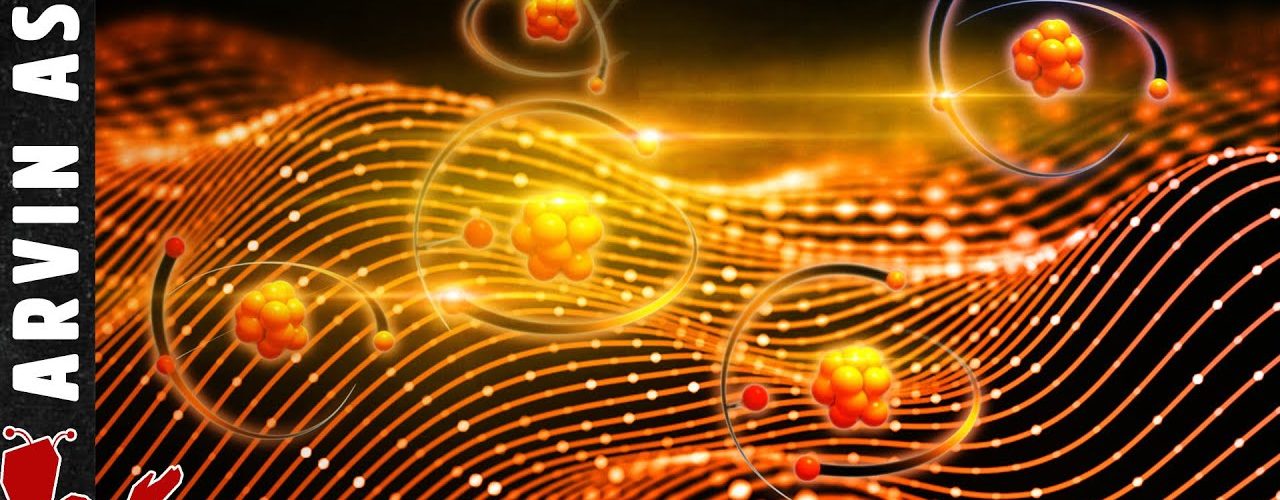Join the conversation on Arvin’s Discord Server: https://discord.gg/uK4exF5jf5
When the nucleus was discovered by Rutherford, it became clear the classical world was not reality, because according to classical electromagnetism, the electron should collapse to the proton. This problem was solved by Niels Bohr who showed that electrons orbit in distinct orbitals, and can only gain or lose energy in chunks, not continuously. Bohr’s atom was based on Max Planck’s simple equation.
Planck introduced Planck’s constant, h, which is the proportionality factor between energy and the frequency of radiation. Bohr noticed that Planck’s constant had units of angular momentum, so he guessed that this was the minimum angular momentum that an electron could have to remain in a stable orbit. He showed that the atom goes from a high energy state to a lower one, proportional to this constant.
Here’s how to derive the uncertainty principle: In the double slit experiment, when monochromatic light goes through two slits we get an interference pattern just like if it was a wave. A single slit produces a similar diffraction pattern where we see a central very high peak, and very faint peaks elsewhere.
The width of the slit represents the uncertainty in position, because the electron could be anywhere along the slit. The distance to the interference pattern represents the momentum. The uncertainty in the momentum is represented by the distance from the center of the pattern to the first interference pattern.
Louis de Broglie showed that the wavelength, lambda for a particle with mass is equal to h/p, where h is Planck’s constant, and p is the momentum. Using trigonometry, we can get a series of equations showing how the uncertainty in position and uncertainty in momentum are equal to h. This is essentially what the uncertainty principle is.
This is slightly different than how the equation is typically written with is greater than or equal to h/4*pi, because of some imprecisions in this approach to the derivation. A more precise approach requires higher level math and use of Fourier transforms. Here’s a link to one such derivation if you are interested:
The important thing to remember is that the uncertainty in the momentum and the position are inversely related. As one gets bigger, the other gets smaller. This is not a limitation of our ability to measure the position and momentum. It is a limitation of reality!
How does this relate to the Bohr model of the atom? The Bohr radius, where Niels Bohr calculated the electron would be at its lowest energy state in the hydrogen atom is 5.29x 10^-11 m. The velocity can be calculated to be 2.18 x 10^6 m/s for the same electron. The mass of the electron is 9.11 x 10^-31 kg.
Now we can calculate the momentum of this electron because momentum is just mass times velocity. This would be equal to about 2 x 10^-24 kg*m/s. But there is always some uncertainty. So for example if there was a 10% uncertainty in velocity, then delta p would be one tenth of this or 2 x 10^-25 kg*m/s.
Calculating from the uncertainty equation, we get: Delta X is 26 x 10^-11 meters. Compared to the Bohr radius, this is 5X larger. A 10% uncertainty in momentum results in a huge uncertainty in the position. It tells us that the Bohr radius is fundamentally wrong. The truth is that the electron doesn’t just sit at any fixed radius. There is a constant balance between the uncertainty in its momentum and position, such that it forms a cloud of probability around the proton. This cloud extends far below and far beyond the Bohr radius. And using the Schrodinger’s equation, we can calculate the probability of finding it at certain locations if we measure it.
So why do we keep teaching students about Bohr’s inaccurate model? It is useful for approximate calculations, and explains a number of features of atoms on the periodic table. It is useful for chemistry.
#uncertaintyprinciple
#heisenberg
If we used the same equation and put in the mass of a tennis ball and a 1% uncertainty in momentum, we get that the uncertainty in the position, equals 1.55 x 10^-33 m. This is so small that we would never notice it. Similarly, we don’t notice it in anything else either that we can see with our eyes.
The big lesson to be learned here is that the central concept in quantum mechanics is only noticeable at very tiny scales.







